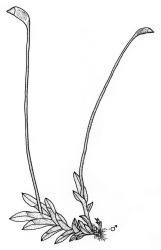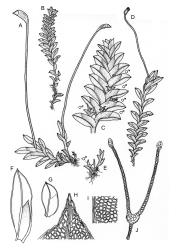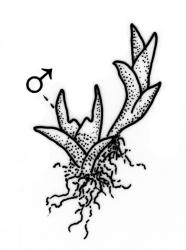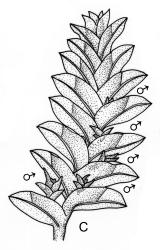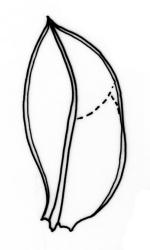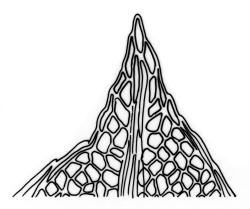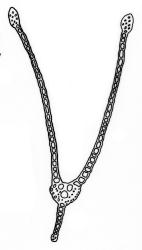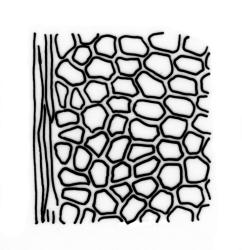Plants heteromorphic, 2–10 mm, yellow-green to mid green, loosely gregarious. Stems simple or branched from near the base, with rhizoids near base only. Leaves in 3–20 pairs, not or scarcely overlapping at mid stem, patent to patulous, plane when moist, crispate when dry, oblong-lanceolate, 0.6–1.2 × 0.2–0.5 mm; apex broadly acute, apiculate; laminae unistratose; vaginant laminae c. ⅔ leaf length, closed; dorsal lamina failing above, or reaching leaf insertion, tapered to its base; margins entire; marginal cells on all laminae distinct in up to 6 rows, very narrow, thick-walled, and prosenchymatous, forming well-defined pluristratose borders that fuse with the costa at the leaf apex, or fail shortly below; cells of apical and dorsal laminae irregularly pentagonal to hexagonal, often wider than long, smooth, non-bulging, moderately thick-walled, (8–)9–12(–15) × (6.0–)7.5–12.0(–15.0) µm. Costa percurrent to excurrent, bryoides-type in cross-section.
Autoicous. Perichaetia terminal; perichaetial leaves longer than vegetative. Perigonia bulbiform, at shoot base only, or axillary on otherwise sterile or female shoots, or apparently attached by rhizoids to the base of female shoots. Setae orange-brown, stiff, 5–13 mm; capsules inclined, asymmetric, 0.8–1.0 mm; operculum apiculate from a conic base, ½ the length of theca. Peristome bryoides-type; teeth with long-columnar papillae on the adaxial trabeculae below the bifurcation, c. 50 µm wide at base. Calyptra scabrous at apex, cucullate. Spores 15–18 µm.
Beever & Stone 1999, fig. 5; Beever et al. 2002, p. 22, figs 1–5.
Although this species and the allied F. viridulus Wahl. and F. incurvus Schwägr. were recorded for N.Z. by Wilson (1854), these records were later rejected by Rodway (1914) and Dixon (1923, p. 108), who suggested they were based on misidentified specimens of F. leptocladus and F. curvatus. Sainsbury (1955) made no mention of the F. bryoides complex. Recent collections confirm, however, the presence of F. bryoides s.l. in N.Z. All fruiting material seen has asymmetric, inclined capsules. The perigonia are bulbiform, produced only close to the base of female or otherwise sterile shoots, or, in addition, in the axils of vegetative leaves well up the stem.
Fruiting plants may have an abrupt transition from juvenile to perichaetial leaves, or there may be a zone of vegetative leaves between them, presumably due to a delay in the timing of the sexual signal to the shoot apex. The resulting plants have a distinct appearance. Some collections (e.g., E. Lürling s.n., AK 236258) also have tall, sterile plants with vegetative leaves to the shoot apex.
The well-developed leaf borders may be confluent with the costa, or fail shortly before the leaf apex.
This species has been confused with F. leptocladus, but F. bryoides has larger (9–12 µm long vs 6.0–7.5 µm long in F. leptocladus), less obscure, and flatter lamina cells.
A puzzling specimen (T.C. Moss s.n., WELT M007544), collected in an urban garden in Wellington City, has leaves that are strongly bordered on the vaginant laminae only. Dorsal laminae are well-developed on both perichaetial and vegetative leaves. It is tentatively referred to F. bryoides.
K; NI: N Auckland, S Auckland, Hawke’s Bay, Wellington; SI: Nelson, Otago; Ch.
Anomalous. Widespread in the northern hemisphere and reported also from South America (He 1998; Pursell 2007). Records from sub-Saharan Africa were not accepted by Bruggeman-Nannenga (2013).
Adventive.
On shaded or exposed mineral soil in highly modified sites, such as pasture, lawns, churchyards, roadsides, planted native shrubberies, and river banks. Associated species include other synanthropic mosses: Ceratodon purpureus, F. curvatus, F. taxifolius, and Tortula truncata.
Records range from near sea level to c. 150 m (Mangawhero River, Wellington L.D.).
Fissidens bryoides is treated here as one highly variable species, as advocated by Pursell (1976) and Crum & Anderson (1981). The species is regarded as adventive in N.Z., as it is known only from highly modified anthropic sites, and there are no reliable records prior to 1968. The variation seen suggests that more than one introduction event has occurred.
An account of F. bryoides in N.Z. was given by Beever & Stone (1999).



